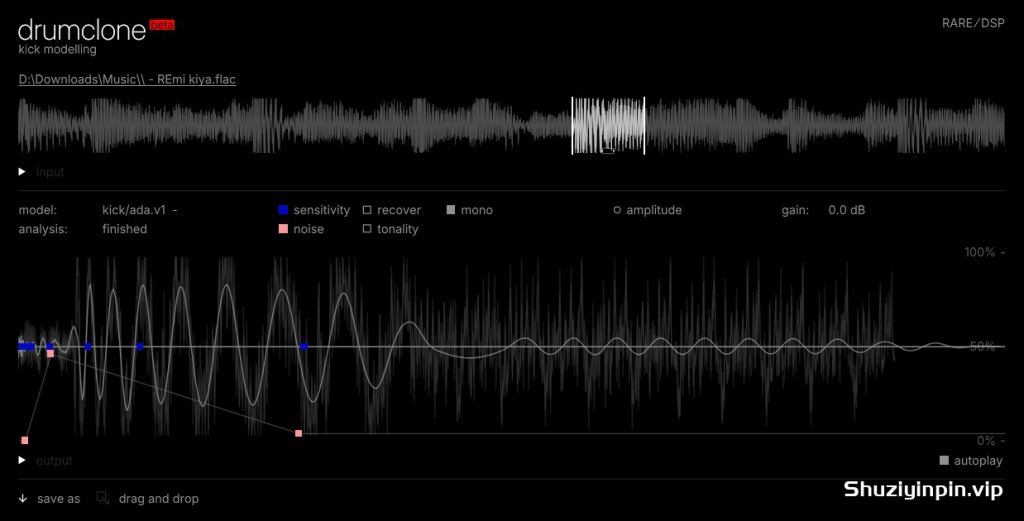
20/11/2024 | VST3 WiN MAC | 8 MB
安装方法
Drumclone 允许从复杂音频源(如歌曲、样本或任何具有可感知打击元素的录音)中提取和修改高质量的单鼓声音。Drumclone 带有模型*,可以精确隔离和重新合成鼓声,由于其亚秒级处理时间和拖放用户界面,可以实现快速的迭代工作流程。虽然它可以用于隔离,但 drumclone 的主要重点是它的声音设计能力。能够模仿一次性打击乐噪音并调整其攻击、瞬态、噪音成分等,直至样本级别。
实际使用情况
在各种音乐制作流派中,使用预制声音或歌曲样本是一种普遍的做法。特别是鼓样本是必不可少的组成部分,通常构成许多作品的结构基础。利用 drumclone,可以从现有录音中提取这些高质量的鼓声,随后进行修改,而不会降低音质。这种方法可以有效地隔离鼓声,并将其从纯正弦波打击乐转变为谐波丰富且失真的鼓声,同时保持足够快的处理速度以实时可视化结果。与传统的提取方法不同,传统的提取方法往往会通过不自然的过滤伪影降低声音的质量并输出静态音频样本,而重新合成可以模拟鼓的原始音色特征,并通过使用简单的面向用户的控件调整底层公式来实现创造性的灵活性。
技术
1. 分析处理从输入的时间和频域分析开始。在时域中提取和建模特征,以帮助检测与频谱域中的打击乐信号相对应的事件和分量。
2. 提取使用针对组件类型量身定制的不同软频谱掩码将组件与输入隔离,这些软频谱掩码围绕检测到的事件和用户指定的包络构建。
3. 重新合成一旦从频谱域重建这些音频层,就会应用动态和立体声处理来优化输出。这些经过过滤的打击乐组件层用作重新合成过程的输入。每个信号都使用一种合成技术进行匹配,该技术可以准确表示其音调和振幅特征。
4 . 混音 + 后处理这是通过使用不同的复音或单音振荡器(正弦波和带通噪声)并生成与输入非常相似的调制包络来实现的。在重新合成之后,各层被混合成一个有凝聚力的立体声音轨。混音中使用了简单的交叉淡入淡出和预定义曲线相加。
最后,立体声和动态处理应用于输出轨道,以实现更自然的声音和可控的音频级别。
功能:
一次性打击乐隔离和再合成。
灵活的瞬态和身体塑形,具有音调和噪音控制。
使用样本级分辨率进行微调。
合成模型可避免典型的滤波隔离伪影。
极其清晰的鼓声输出,可应用进一步的处理链。
波形中每个变化的实时可视化。
快速拖放工作流程。
完全离线,不涉及云或服务器。
在常见硬件上处理时间为亚秒级。
多段包络编辑器可准确塑造底层模型。
具有数据可视化和内联控件的低调矢量 UI。
系统要求
Drumclone allows extracting and modifying high-quality single drum sounds from complex audio sources like songs, samples, or any recording with perceptible percussive elements. Drumclone comes with models* to precisely isolate and resynthesize drum sounds, which allows a fast iterative workflow thanks to its sub-second processing times and drag and drop UI. While it works for isolation, drumclone’s main focus is it’s sound-design capabilities. Being able to imitate one-shot percussive noises and tweak their attack, transient, noise component, etc, down to the sample-level.
Real-world usage
The utilization of pre-made sounds or song samples is a prevalent practice across various music production genres. Drum samples, in particular, serve as essential components, often forming the structural foundation of numerous compositions. Utilizing drumclone, these high-quality drum sounds can be extracted from existing recordings and subsequently modified without any degradation in sound quality.
This methodology can effectively isolate a drum sound and mutate it from pure sine-like percussion, to harmonically rich and distorted drum sounds, while keeping the processing fast enough to visualize the results it in real-time.
Unlike traditional extraction methods, which tend to degrade the quality of the sounds with unnatural filtering artifacts and output static audio samples, resynthesis can model the original timbral characteristics of the drums and allows creative flexibility by tuning the underlying formula with simple user-facing controls.
Technology
1. Analysis
Processing starts with time and frequency domain analysis of the input. Features are extracted and modeled in the time domain to aid in detecting events and components corresponding to percussive signals in the spectral domain.
2. Extraction
Components are isolated from the input using different soft spectral masks tailored to the component type, built around detected events and user-specified envelopes.
3. Resynthesis
Once these audio layers are reconstructed from the spectral domain, dynamics and stereo processing are applied to refine the output.
These filtered percussive component layers serve as the input for the resynthesis process. Each signal is matched using a synthesis technique that accurately represents their tonal and amplitude characteristics.
4. Mix + post-processing
This is achieved by using different polyphonic or monophonic oscillators (sine and band-passed noise) and generating modulation envelopes that closely resemble the input.
Following resynthesis, the layers are mixed down into a cohesive stereo track. Straightforward cross-fading and summing with predefined curves are employed in the mix.
Finally, stereo and dynamics processing are applied to the output track to achieve a more natural sound and controlled audio levels.
Capabilities:
One-shot percussion isolation and resynthesis.
Flexible transient and body sculpting with tone and noise controls.
Fine-tuning with sample-level resolution.
Synthesis models to avoid typical filtering isolation artifacts.
Extremely clear drum sound output for applying further processing chains.
Real-time visualization of every change in the waveform.
Fast drag-and-drop workflow.
Fully offline, no cloud or servers involved.
Sub-second processing times on common hardware.
Multi-segment envelope editors to accurately shape the underlying model.
Low-profile vector UI with data visualization and inline controls.
System requirements
Installation

![[母带立体声效果器]Mathew Lane DrMS v5.2.4 v4.0 [WiN, MacOSX](37.8MB)](https://www.shuziyinpin.vip/wp-content/uploads/2025/04/1521810270_mathew-lane-drms.png)
![[黑公鸡插件包]Black Rooster Audio The ALL Bundle v3.0.0 [MacOSX](1.6GB)](https://www.shuziyinpin.vip/wp-content/uploads/2025/04/15042537_blackroosteraudio_allbundle_box_medium.png)
![[袖珍型律动盒]Sugar Bytes Dialekt v1.0.0 [WiN](315.6MB)](https://www.shuziyinpin.vip/wp-content/uploads/2025/04/17042515_s1_2159x1444.jpg)
![[高级沉浸式环绕混响]iZotope Equinox v1.0.0 [WiN, MacOSX](114.24MB+)](https://www.shuziyinpin.vip/wp-content/uploads/2025/04/17042527_izotope-equinox.png)
![[新品:虚拟吉他手]uJAM Virtual Guitarist CINEDREAM v1.0.0 U2B [MacOSX](3.6GB)](https://www.shuziyinpin.vip/wp-content/uploads/2025/04/c6a2f797-05cc-4f44-96c7-e718ad15a105.png)
![[更新:革命性智能和弦插件]Scaler Music Scaler 3 v1.0.5 Regged [MacOSX](1.1GB)](https://www.shuziyinpin.vip/wp-content/uploads/2025/03/DC-Scaler-3-Website-2-1024x748.png)

评论0